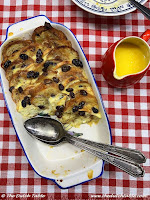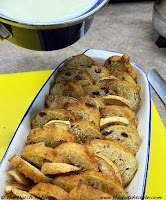Every now and then, when looking for new recipes in my Dutch cookbooks, memories flood back when I see a name or an ingredient. Other times, it happens when readers like you comment on the recipes or posts, either on Facebook or Instagram. So too last week, when I posted the recipe for
stroopkoeken, a reader mentioned that their favorite cookie was not so much a
stroopkoek, but a
slagroomwafel, a whipped cream waffle. The moment I read the comment I was straight back in my childhood, standing next to my grandpa Tinus, at the little window of the ice cream shop in town. I loved getting the little square waffle cone, topped with a big swirl of soft serve ice-cream. It fit right in my little fist. My grandpa, who had as much of a sweet tooth as I have, would sometimes get a
slagroomwafel: a big, round crispy waffle, topped with what seemed to me a massive amount of freshly whipped cream, and sandwiched with another waffle. It was a messy endeavor, but oh boy.....worth every dribble on his shirt by the look on his face!
There is not much known about slagroomwafels: just two crispy sweet waffles sandwiched together with a huge dollop of freshly whipped cream. I've found references to it going back as early as 1917 - but no recipes, regional references, or specific holidays or celebrations that it belongs to. Both ingredients are standard fare at the ice cream shops: crispy waffles for ice-cream waffles (one or two big scoops of ice cream between two waffles), and freshly whipped cream to go on top of ice cream sundaes, so often slagroomwafels are also on the menu. A few bakeries will include slagroomwafels in their repertoire, but it's not very common anymore.
Which is a shame really, because the combination of sweet whipped cream and a crispy waffle truly is delightful. Messy, but delightful. And what's even better is that, because it's so "plain", if you will, and there are no specific details about how and when to make them, this recipe lends itself to personal adjustments. Prefer to flavor the waffle with speculaaskruiden? Go for it! Want to fold chopped strawberries into the whipped cream? Do it!
For this recipe, I tried a few things: I served the cream directly on the waffle (for eating, it's best to pull the two waffles apart and share the slagroom between the two of them ). I also piped whipped cream in circles on a baking sheet lined with parchment paper, froze them overnight (now you have an ice cold treat) and assembled the waffles shortly before sharing them, adding raspberries in the center.
Lastly, I piped whipped cream on a waffle, added raspberries, topped it with another waffle, and froze the whole thing overnight. To my surprise, the waffles stayed crispy. So plenty of options to try!
For this recipe, I used my trusted Palmer Electric Waffle Iron. The recipe makes approx. 16 single waffles. For more shopping recommendations, scroll to the bottom of the page.
SlagroomwafelsFor the waffles1 cup (150 grams) all-purpose flour
3/4 cup (150 grams) sugar
6 Tbsp (60 grams) butter, melted and cool
1 egg
1/2 tsp vanilla extract
Pinch cinnamon
For the whipped cream
2 cups (475 ml) whipping cream
1 cup (120 grams) powdered sugar
Decoration
1 tablespoon powdered sugar
Fresh fruit (optional)
Mix the flour with the sugar, then stir in the melted butter, the egg, the vanilla and the optional cinnamon. Knead into a cohesive dough, remove from the bowl, roll into a sausage shape. Cover with plastic, or put in container, and refrigerate for at least an hour.
Heat up your waffle iron according to the manufacturer's instructions. Remove the dough from the fridge, and divide it into 1 oz (approx. 25 grams) pieces, then roll each into a ball.
Bake your waffles until they are golden. The time will differ between irons so you will just have practice a little bit. Remove the waffles when they are done, with a flat, broad implement (I use my cheese slicer) because they will still be soft when hot, but will harden as they cool, so lay them flat on a rack to cool off.
Whip the cream in a cold bowl until soft peaks, sieve in the powdered sugar, and continue to whip until stiff peaks. Fill a piping bag with a star tip. Pipe a large double circle on a waffle, add fresh berries in the middle (optional) and top with another waffle. Dust with powdered sugar.
You can serve them directly, or freeze them for later. If you have any whipped cream left over and no immediate use for it, you may want to try and pipe big dollops on a baking sheet, and freeze them. They make a great last minute addition to a hot cup of coffee or chocolate!
Amazon Prime Shopping Suggestions:
Disclaimer: if you buy through any of the links in the Amazon Prime Shopping Suggestions section, the Amazon Services LLC Associates Program will pay us a small commission on qualifying purchases. It does not increase your cost or price, and it will help us keep the website running. Your support is very much appreciated!
Don't have Amazon Prime but want to give it a try? This link offers a 30 day trial.













